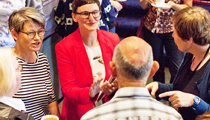This website uses cookies so that we can provide you with the best user experience possible. Cookie information is stored in your browser and performs functions such as recognising you when you return to our website and helping our team to understand which sections of the website you find most interesting and useful.
ED2013 Art ED2013 Interviews ED2013 Week3 Edition
Mary Paulson-Ellis & Audrey Grant: Exploring artists and their materials
By Chris Cooke | Published on Tuesday 20 August 2013

Ruffled Russell is the creation of writer Mary Paulson-Ellis and painter Audrey Grant, who – having decided to collaborate on a project together that was outside both their usual domains – produced an illustrated children’s book featuring an existential Jack Russell dog.
It’s that collaboration that goes under the spotlight in the art section of this year’s Edinburgh International Festival, with a small exhibition at The Hub that showcases the two creators’ creative processes, and the various outcomes that have stemmed from their original idea.
We spoke to both writer and artist about the specific book in the spotlight – ‘Ruffled Russell And The Lost Soul’ – and found out more about the exhibition it has resulted in.
CC: Where did the idea for ‘Ruffled Russell And The Lost Soul’ come from?
M&A: Our character, Ruffled Russell, came about because we wanted to explore how it felt to be a dog that constantly questioned the meaning of life, while trapped inside the body of a Jack Russell terrier. The story about the ‘Lost Soul’, meanwhile, was inspired by looking at the anatomy drawings of Leonardo da Vinci. Da Vinci was on a quest for knowledge about the human body and how it worked, but during his era people also believed the soul resided within the body as a physical organ much like a heart or a liver. From this we developed the idea of a dog that journeys through the human body in search of some kind of meaning (aka a soul).
CC: As well as da Vinci, the works of Darwin and Beckett were also inspirations. Are elements of each of those men’s work obvious in the book?
M&A: Beckett’s influence is more subtle, having been captured within the character of a dog that constantly explores the human condition. However, we have used Darwin’s ‘Tree Of Life’ diagram, illustrating that all species evolve from a common ancestor, as a central visual motif for the exhibition. The diagram acts a a metaphor for the the creative process, where one single idea – an existential Jack Russell – can take many different paths. Darwin’s diagram, and other trees, appear throughout the artwork in various forms, as do recreations of Leonardo da Vinci’s anatomy drawings.
CC: Were there educational objectives for the book?
M&A: No, not for the book. But the exhibition was designed to give an insight into the influences, techniques and materials used during the development of a particular creative idea.
CC: How did the two of you come to work together on the project?
M&A: We have known each other for a long time and came together because we wanted to work on a project that was outside our normal practice.
CC: How does it work – does Mary write the story and Audrey then create the images – or is it more collaborative than that?
M&A: It is more collaborative. We both bring ideas to the table – about character, story, visual aesthetics etc – and explore and refine these until we find one that has ‘legs’. After that Mary develops text and storyboarding, while Audrey experiments with specific artworks.
CC: How much did Mary describe the pictures in her mind to Audrey, or did Audrey create the images simply from the words of the story?
M&A: Audrey used the whole concept of character and story, as well as the actual words, to create her artwork. Mary created storyboards to explore certain visual ideas and how the narrative might flow, as well as writing the text.
CC: What motivated the exhibition?
M&A: The Edinburgh International Festival wanted to look at how artists develop their ideas in the most fundamental way, whether they are using traditional technologies such as paper, pencil, paint and ink, as here, or cutting-edge technologies such as those on display in other EIF shows in this year’s programme.
CC: What does the exhibition feature?
M&A: The main feature is a large, blackboard wall – a recreation of one
of the artworks itself – on which are displayed a selection of Audrey’s original artwork; x-rays sourced from the archive of George Romanes, a former Professor Of Anatomy at the University of Edinburgh; text from the final story; phrases from Leonardo da Vinci’s anatomy manuscripts; and little cut-out images of the dog. On another wall is a large scale print-out showing how the Festival’s graphic designer transformed one of the artworks into a spread for the book. There is also a slideshow illustrating how the project evolved, and three books – Mary’s sketchbook exploring text and image, a screen-printed artists book introducing the character of the dog, and a hard cover demonstration picture book that includes a number of full-colour graphically designed pages.
CC: Being both a writer and an artist can be quite solitary tasks, was a collaborative project of this kind more rewarding?
M&A: Collaborative working is more challenging because you have to take on board someone else’s ideas, whereas normally we would focus purely on our own ideas. However, coming up with something unique and distinctive as a result of working together is very satisfying because you know it could not have been achieved in any other way.
‘Ruffled Russell And The Lost Soul: Artists And Their Materials’ was a free exhibition at The Hub during Edinburgh Festival 2013.
LINKS: www.eif.co.uk






